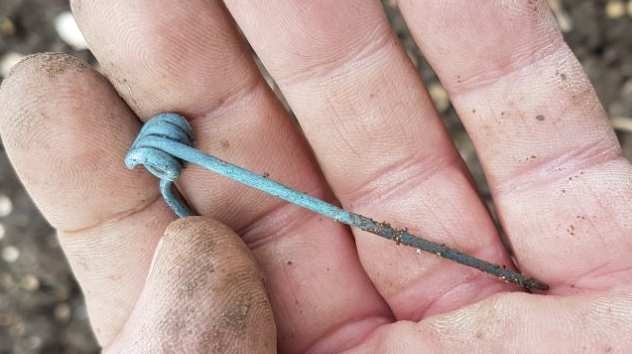-
Posts
565 -
Joined
-
Last visited
Content Type
Forums
Detector Prospector Home
Detector Database
Downloads
Everything posted by PimentoUK
-

So Can We Be Critical Of Deus II Here?
PimentoUK replied to Chase Goldman's topic in XP Deus II Forum
"The Coil heartbeat indicator: there is concern that it will cause premature drain of the coil battery" Speaking as an electronics engineer, the extra power drain caused by the LED, and associated electronics, is completely trivial. As there is no proper On/Off switch for the coil, there is inevitably going to be some drain, you just have to trust the designers to keep this to realistic levels. And there's no need for them to go to extreme measures, either, as the Li cell will self-discharge anyway. ---- I've not followed the D2 threads closely, but wasn't the pinpoint function considered inconvenient to use? Anyone who has used trigger-operated pinpoint, such as the Teknetics T2, will know how intuitive and ergonomic it can be. So an over-complex system is undesirable. -
My guess is that it wasn't commercially viable. Assuming it was 'Typical Deus' in operation, with integrated electronics in the coils, it would have retailed at a pretty high price, probably the same as, or more than, dedicated two-box machines ( C-Scope / Fisher / Whites ). The concept of making a two-box add-on for a conventional machine is reasonable enough, Garrett did it. Normally this would mean just 2 coils and the hardware to hold it all, so it would be a realistic price. But it's a pointless concept on a Deus, as almost a complete new detector is needed. (Since the closing of Whites, there is less choice now if you're after a two-box, but I still don't think this help XP sell their version.)
-
Quote: "So the signal strength increases but the dTID stays the same. Good to know" Maybe I should add some pictures to that post, to make it less 'wordy'. If you feel experimental, try testing a 10mm ( 3/8" ) length of wire. Same result, I hope. The test samples we used were 19.0mm ( 3/4" ) long, for consistency. When the wire gets thin, it's not easy getting a strong enough signal to measure properly. So two alternative approaches were tried : multiple 19mm lengths, or a single longer length, both worked fine. Here's an example of a real-world target giving the 'wire' problem: this is the fixing pin off a Roman bow brooch, made of bronze, found by a guy on a UK forum. He saw it sticking out the soil, ran his French stick over it, to be met with silence. Only after some fiddling with the settings and pretty much scraping the coil over it did he get a poor beep, with a super-low ID value. The two problems here: the diameter ( about 1.7mm estimate ) and the metal : bronze, AND corroded. Now if it were nice pure copper, it could ID in the 5c 'nickel' range. But the unknown metal conductivity is going to be anywhere from 1/5th to 1/20th of that. This pushes up the target freq to 100 kHz, 200+ kHz, so even an 18kHz machine will struggle to see it, in motion-mode, anyway.
-
Ahh, better data, thanks. Your measurements are in good agreement with the scientific tests we did ( on the Geotech1 forum ). I calculate ( with Eqx TID ) 2.0mm : freq = 13.5 kHz, TID = 14 2.2mm : freq = 11.3 kHz, TID = 16 3.2mm : freq = 6.1 kHz, TID = 20 There's a bit of leeway allowed, I'm converting from F75 readings to Eqx ones, I never got round to 'calibrating' the Eqx ID's, in part because they covered a rather small useful range. In case anyone's slightly interested, here is the maths: We found the target time-constant was proportional to the cross-sectional area of the wire, and proportional to the electrical conductivity of the metal, and the result was this formula: TC = 0.029 * D * D * %IACS where TC = time-constant ( in microsecs ); D = wire diameter ( mm ); %IACS = metal conductivity. Example: 2mm diameter copper, TC = 0.029 * 4 * 102 = 11.8 usec To convert time-constant into target frequency use this: target freq, f = 1/ ( 2* pi * TC ) with TC in seconds using the above TC as an example, this gives 13.5 kHz It's a good straight-line match for wires up to 2.5mm, then it starts to drift away a bit , due to skin effect; the full diameter of the wire is not all seen. PI machines don't see this so badly. But regarding: "Not surprisingly the in-field dTID's vary with length and shape" I think you may have missed the main point of my earlier post : TID does NOT vary with wire length, unless you have very short lengths. It can depend a bit on shape, irregular objects commonly give erratic ID's.
-
Quote: "I find quite a bit of copper wire -- single stranded. The gauge is in the 12-16 range. They typically hit in the USA zinc penny and aluminum screw cap range." Assuming that's American Wire Gauge, AWG, that is 2.05mm to 1.29mm. Mathematics tells me that would be the target frequency range 13 kHz to 34 kHz, respectively. On the ID scale, 13 kHz is above US 5c coins ( 16.5 kHz) but way below 'zinc cent' ( 5 kHz ) , and 34 kHz is down in the foil zone . So I'm unsure why you're getting your wire come in at '5 kHz'.
-
Another non-intuitive target is the long-and-thin type. Such items include wire ( copper or brass, typically ), plain finger-rings that are broken ( C-shape ), copper/bronze/aluminium nails. Metal detectors induce circulating electrical currents in the target that tend to form loops as large as they can, without straying too far from 'circular'. So for a wire, these current loops are little more than the wire diameter in size, they don't go up-and-down the length of the wire at all. There are many of these loops along the wire, so they all contribute to giving a stronger response to the detector, but the 'target frequency' is still that of a very short snippet of wire, no more than twice the diameter. So wires tend to have very a high 'target frequency' , that's independant of their length. This can make them hard to detect. An extreme example : among my electronics junk, I have some test coils that are much like the windings inside a detector search-coil. 100 turns of 0.2mm enamelled copper wire, over 20 grams of highly-conductive metal in total. But place one 5mm from a detector coil, it is invisible. The target freq is about 2.5 MHz, so it's not going to match any commercial machine.
-
Copper and silver seem pretty compatible, maybe the alloy curve is rather dull, hence not worth studying? The reference I used for gold-copper , and nickel-copper alloys is this weighty pdf: https://srd.nist.gov/JPCRD/jpcrd221.pdf is that the same as the one just posted .. ah yes, just the filesize is different, making me question it.
-

Henry 3 Gold Penny Found
PimentoUK replied to Steve Herschbach's topic in Metal Detecting For Coins & Relics
Indeed, the tin mines were in Cornwall , the most South-West point of England, and the tunnels went out under the Atlantic: Here's an article, sorry it's the Daily Mail, they spam adverts and trash all over the page: https://www.dailymail.co.uk/news/article-2285245/Cornwall-tin-mines-How-quest-metal-took-men-just-feet-ocean-floor.html And one of the mines is now a tourist attraction: https://www.visitcornwall.com/things-to-do/attractions/west-cornwall/lands-end/geevor-tin-mine -
Steven : It's electrical conductivity ... how good would it work if you made an electric cable out of it ? Copper, silver = great choices bronze = not that good lead, tin = going to need pretty thick wire cupro-nickel, stainless steel = they will be glowing red all the time Here's a decent reference table for many 'industrial' metals/alloys: http://eddy-current.com/conductivity-of-metals-sorted-by-resistivity/
-
The relationship between shape/size , metal and its conductivity, and target frequency is potentially quite complex, and results in plenty of variety, that will easily surprise anyone not well educated on the topic. Most metals we dig are not 'laboratory grade' pure elements, they are either impure, or intentionally-created alloys, often with unknown properties. Alloys can have vastly different properties to their constituent elements ... far from intuitive. For example .900 fine gold ( or 22ct / .917 alloy ) has an electrical conductivity about one-sixth that of pure gold, even though the 10% that isn't gold is copper, one of the best conductors. The conductivity of .900 gold is near-identical to pure tin, which is a pretty poor conductor if you look. Likewise, the cupro-nickel alloy used in the US 5c coin, and many other world coins, is an especially lousy electrical conductor. It's widely used as electrical resistance wire, in heaters, kettles, hairdryers, electronics resistors. But it's 60% copper, not really what you'd expect. And corrosion can make a big difference to real-world conductivity. It's one of the reason some of our ancient silver coins read quite low down the ID scale. Despite them originally being .925 Sterling Silver, the copper tends to leach out, leaving the remaining metal porous and sponge-like, so electricity doesn't pass easily through it. Low conductivity means low ID. An example where physical shape gives non-intuitive behaviour is finger-rings ( or any ring shape item, like washers, for example ). It turns out that changing the diameter of a finger ring has hardly any affect on the target frequency / ID value. Scientifically speaking: if you double the diameter of a ring, you double the electrical resistance around the 'loop' , that's pretty obvious. What's less obvious is that the inductance of the loop also almost doubles, too. These two doublings pretty much cancel out, as ( inductance divide by resistance ) determines target ID. This can explain why very small copper washers can give impressively high ID values. It can even be tested practically - fabricating copper wire rings of different major diameter, but the same wire gauge is not too hard. Sweep them over the coil and the results can be seen.
-

Henry 3 Gold Penny Found
PimentoUK replied to Steve Herschbach's topic in Metal Detecting For Coins & Relics
Yes, we had good deposits of iron ore, lead and tin. The lead also contained silver, as a bonus. The Romans were pretty skilled at metallurgy; bronze, pewter, solder were all tin-containing metals. https://www.romanobritain.org/11_work/raw_mining.php -

Henry 3 Gold Penny Found
PimentoUK replied to Steve Herschbach's topic in Metal Detecting For Coins & Relics
There is native gold in the U.K , there are deposits running down the west coast of Scotland, through to the central mountains of Wales. Some was extracted from the rivers, and in Roman times, there was some mining in Wales. But most of our gold was imported from the continent. Roman mine in Wales: https://en.wikipedia.org/wiki/Dolaucothi_Gold_Mines Some background reading on gold artefacts in the UK from Roman to Medieval times: https://finds.org.uk/counties/blog/gold-working-in-the-roman-and-medieval-periods/


